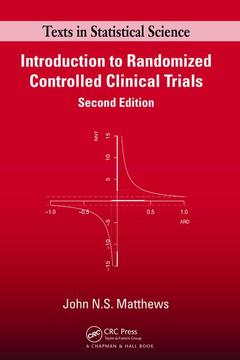Description
Introduction to Randomized Controlled Clinical Trials (2nd Ed.)
Chapman & Hall/CRC Texts in Statistical Science Series
Author: Matthews John N.S.
Language: English
Subject for Introduction to Randomized Controlled Clinical Trials:
Keywords
Null Hypothesis; Minimal Clinically Important Difference; hypothesis; Cumulative Distribution Function; variable; Simple Randomization; treatment; Interim Analysis; group; Neonatal Hypocalcemia; effect; Allocation Bias; minimal; Treatment Effect; clinically; Assessment Bias; important; Survival Time; difference; Antenatal Steroid Therapy; Plaque Size; RPBs; Vas Score; Placebo Effect; Placebo; Fixed Effects Model; Kaplan Meier Estimator; Inoperable Tumors; Biased Coin Design; Blue Tablets; Sample Size Calculations; Log Odds Ratio; Interval Estimate; Sea Water
Publication date: 10-2017
· 15.6x23.4 cm · Hardback
Approximative price 93.24 €
Subject to availability at the publisher.
Add to cartPublication date: 06-2006
· 15.6x23.4 cm · Paperback
Description
/li>Contents
/li>Readership
/li>Biography
/li>
Evidence from randomized controlled clinical trials is widely accepted as the only sound basis for assessing the efficacy of new medical treatments. Statistical methods play a key role in all stages of these trials, including their justification, design, and analysis. This second edition of Introduction to Randomized Controlled Clinical Trials provides a concise presentation of the principles applied in this area. It details the concepts behind randomization and methods for designing and analyzing trials and also includes information on meta-analysis and specialized designs, such as cross-over trials, cluster-randomized designs, and equivalence studies.
This latest edition features new and revised references, examples, exercises, and a new chapter dedicated to binary outcomes and survival analysis. It also presents numerous examples taken from the medical literature, contains exercises at the end of each chapter, and offers solutions in an appendix. The author uses Minitab and R software throughout the text for implementing the methods that are presented.
Comprehensive and accessible, Introduction to Randomized Controlled Clinical Trials is well-suited for those familiar with elementary statistical ideas and methods who want to further their knowledge of the subject.




